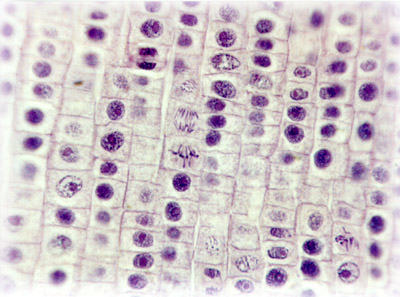
|
Cell division - Mitosis
by Anne Bruce |
|
When you look at a cell under a microscope it is usually fairly easy to see its nucleus which shows up as dark body within the cytoplasm of the cell. The nucleus contains chromosomes made up of genes. The genes can be thought of as the "recipe book of life" because they determine the organism's characteristics and all the chemical reactions which take place within its cells. Accurate replication of the chromosomes is therefore vital if the new cells produced are to function effectively. Unless a cell is about to divide, or is in the process of dividing, the chromosomes within its nucleus are not obvious. However, just prior to dividing, the chromosomes shorten and thicken and become more obvious. (The name chromosome is derived from the Greek meaning "coloured body"). |
|
Q. What do asexual reproduction, repair and growth in animals and plants all have in common? A. All produce new cells Q. How are accurate copies of the cells made? A. By the process of cell division called MITOSIS
|
| Single celled
organisms often reproduce asexually by binary fission, or splitting
into two. The two new organisms that are produced are identical to each
other and to the parent cell.
In animals, growth takes place all over the animal's body until it reaches full size. Cells in certain areas, such as the skin, still retain the ability to grow and divide. In plants, growth occurs in specialised areas called meristems which are situated in the root and shoot tips. Cell division here results in increase in length. Meristem tissue between the phloem and xylem (called cambium) results in increase in the plant's girth. Mitosis is the mechansim involved in all these processes, it is the type of cell division1 where 2 new cells are produced from a single cell. The two new cells have the same number of chromosomes as the parent cell and are identical to it and to each other. Multicellular organisms have a huge variety of different types of cell; humans have around 200 different cell types, all of which are derived from a single fertilised egg cell. New cells produced by mitosis differentiate and become specialised. Each cell type has specific genes "switched on" or "switched off" so that it can carry out its particular function. The following images showing the process of mitosis were taken from a slide of a longitudinal section through a Broad Bean (Vicia faba) root. The area of cell division is just behind the root tip. |
| Various stages of mitosis can be observed in the section on the right. By looking at several sections, it is possible to identify the sequence of events which makes up the process of mitosis. |
|
|
|
Next page for the sequence of mitosis
|
Another type of cell division is meiosis, which results in the formation of 4 new cells which have half the number of chromosomes of the parent cell. Meiosis occurs when sex cells (gametes) are produced.(back to text) |
WIDTH=1